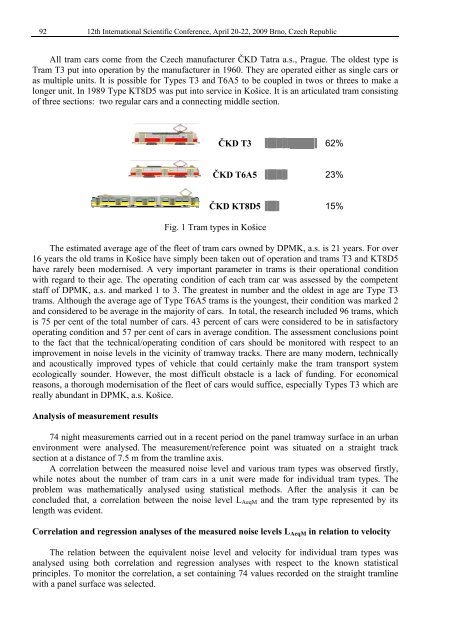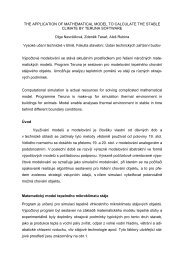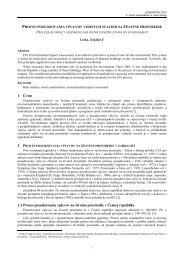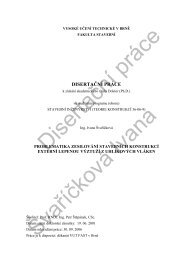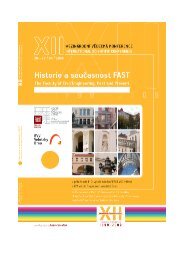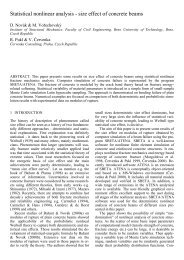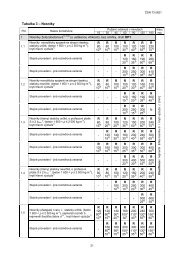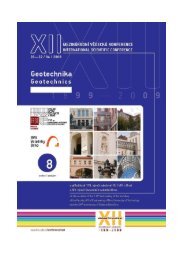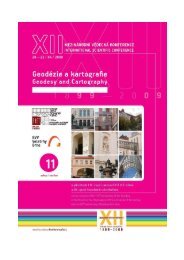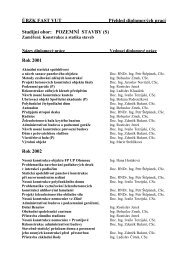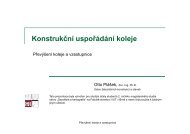Dopravnàstavby - Fakulta stavebnà- Vysoké uÄÂenàtechnické v Brně
Dopravnàstavby - Fakulta stavebnà- Vysoké uÄÂenàtechnické v Brně
Dopravnàstavby - Fakulta stavebnà- Vysoké uÄÂenàtechnické v Brně
You also want an ePaper? Increase the reach of your titles
YUMPU automatically turns print PDFs into web optimized ePapers that Google loves.
9212th International Scientific Conference, April 20-22, 2009 Brno, Czech RepublicAll tram cars come from the Czech manufacturer ČKD Tatra a.s., Prague. The oldest type isTram T3 put into operation by the manufacturer in 1960. They are operated either as single cars oras multiple units. It is possible for Types T3 and T6A5 to be coupled in twos or threes to make alonger unit. In 1989 Type KT8D5 was put into service in Košice. It is an articulated tram consistingof three sections: two regular cars and a connecting middle section.ČKD T3 62%ČKD T6A5 23%ČKD KT8D5 15%Fig. 1 Tram types in KošiceThe estimated average age of the fleet of tram cars owned by DPMK, a.s. is 21 years. For over16 years the old trams in Košice have simply been taken out of operation and trams T3 and KT8D5have rarely been modernised. A very important parameter in trams is their operational conditionwith regard to their age. The operating condition of each tram car was assessed by the competentstaff of DPMK, a.s. and marked 1 to 3. The greatest in number and the oldest in age are Type T3trams. Although the average age of Type T6A5 trams is the youngest, their condition was marked 2and considered to be average in the majority of cars. In total, the research included 96 trams, whichis 75 per cent of the total number of cars. 43 percent of cars were considered to be in satisfactoryoperating condition and 57 per cent of cars in average condition. The assessment conclusions pointto the fact that the technical/operating condition of cars should be monitored with respect to animprovement in noise levels in the vicinity of tramway tracks. There are many modern, technicallyand acoustically improved types of vehicle that could certainly make the tram transport systemecologically sounder. However, the most difficult obstacle is a lack of funding. For economicalreasons, a thorough modernisation of the fleet of cars would suffice, especially Types T3 which arereally abundant in DPMK, a.s. Košice.Analysis of measurement results74 night measurements carried out in a recent period on the panel tramway surface in an urbanenvironment were analysed. The measurement/reference point was situated on a straight tracksection at a distance of 7.5 m from the tramline axis.A correlation between the measured noise level and various tram types was observed firstly,while notes about the number of tram cars in a unit were made for individual tram types. Theproblem was mathematically analysed using statistical methods. After the analysis it can beconcluded that, a correlation between the noise level L AeqM and the tram type represented by itslength was evident.Correlation and regression analyses of the measured noise levels L AeqM in relation to velocityThe relation between the equivalent noise level and velocity for individual tram types wasanalysed using both correlation and regression analyses with respect to the known statisticalprinciples. To monitor the correlation, a set containing 74 values recorded on the straight tramlinewith a panel surface was selected.


